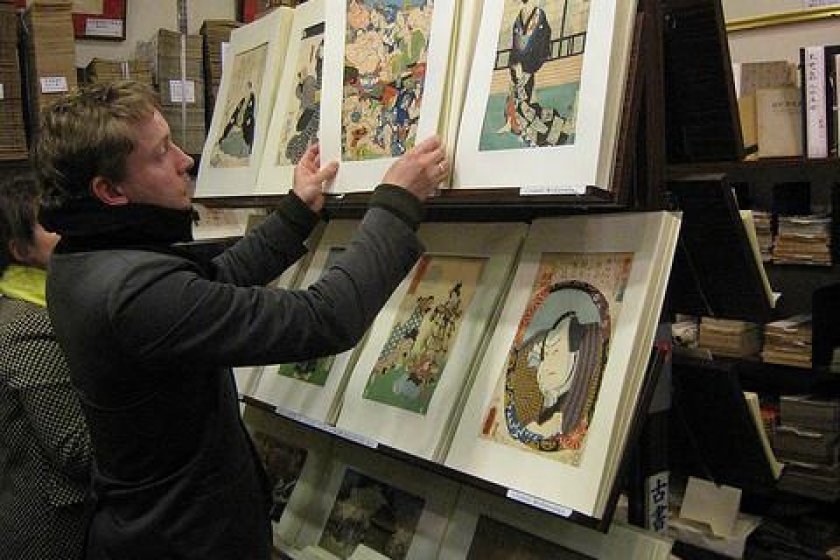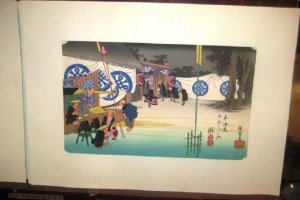Teramachi, or the temple district, has a split personality. The northern half is known for its quiet handicraft shops, cafes, and art galleries. The southern half, on the other hand, is a covered shopping street (shotengai in Japanese), filled with game centers, pachinko parlors, fashion and shoe stores for the young and young at heart. Yet in the midst of this glitz, and moments from the Nishiki Food Markets, is Daishodo Rare Books and Prints, an Aladdin’s cave for fine art collectors and historians alike.
Daishodo is very much a family owned bookshop, and while it may not have the musty air of the Kobayashi’s suburban bookshop portrayed in Haruki Murakami’s novel Norwegian Wood, it retains the old world charm of 1920s Taisho Japan from when the bookstore was first opened. Its small footprint gives an intimacy that is intensified when you find that rare print that you were always searching for, but can’t scream out loud with joy for want of shaking the ghosts of these monumental masters.
The joy of this bookstore extends beyond books, with their collection of Karuta, (Japanese traditional card games), Ukiyo-e (woodblock prints), Sōsaku-Hanga (creative prints), Shin Hanga (new prints), and old match box labels, all in brilliant condition for your enjoyment and edification.
The vintage Japanese matchbox labels in particular give an insight into the fashion at the height of the 1920s, particularly the newly emerging café and cabaret culture and the liberated modern girl (moga) fashion, with permed hair, cigarettes and a cocktail glass in hand. Many of these prints may never be made again, so you should immerse yourself in this prized museum and temple to Japanese art, history and culture.
Sōsaku-hanga was a movement that started in the turn of the twenty-first century, one that was given momentum by Yamamoto Kanae’s painting of a fisherman in 1904. He also gave birth to the Children's Free Painting Society and the Farmers' Art Movement, where he taught various art forms from wood carving to painting. In contrast to traditional ukiyo-e, Sōsaku- Hanga artists would design and carve the woodblock templates themselves, giving them a very tactile connection with their work.
Yamamoto’s paintings are noted for their individualism, a trait that was almost considered non-Japanese at the time, but one that resonated with a country moving from feudalism to modernity and the rise of industrialism. His portrayals of nature and man’s place in it are simple, almost abstract, yet colorful and reflective. It is a worthy heir to the ukiyo-e tradition. Other Sōsaku-hanga artists include Hajime Namiki, Kitaoka Fumio, Maki Haku, Yamaguchi Gen, Yoshida Hodaka, Tajima Hiroyuki, and Onchi Kōshirō.
If on the other hand, you are yearning for a Japan that is more dreamlike, romantic and idealized, Shin-Hanga paintings, popularized in the Taisho period of the 1920s, could be just the ticket. Artists like Kaburagi Kiyokata, Itō Shinsui and Kawase Hasui re-interpret Ukiyo e with a western, more realistic appearance and lighting, making it a form of neo-Ukiyo-e. These paintings might be what you have always been looking for to complement your Japanese or Western inspired home or office.



































Unfortunately the shop owner is a terribly rude and unpleasant man - the opposite of what you expect a Japanese gentleman to be. To make things worse, his woodblock prints are overpriced and many are of dubious quality. Stay away from this shop, if you can.
For really high quality and reasonably priced Japanese prints I recommend HARA SHOBO in Jimbocho, Tokyo. If you are in Kyoto, try the Ukiyoe Museum shop in Sijo Kawaramachi - across the road from the Teramachi Arcade entrance.
Hope this helps.
Enjoy your visit to Japan.
Pedro